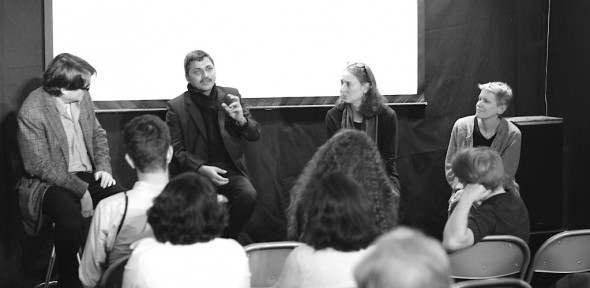
Annette Danto (continued): As a documentary, there are beautiful images. There really are exotic, amazing images. The sound is not observational. The sound is exaggerated at different points. So, for example, the opening sequence with the dogs. The sound was so, so exaggerated to really highlight this barbaric tearing apart of another dog. It was meant to open the film in a really strong and really harshly negative way. And I think, that is not observational documentary filmmaking. That is a narrative construction. It’s really trying to use sound for dramatic effect. For the most part, the soundtrack is used in an exaggerated way. There’s not music. There’s no narration. But there’s lots of dialogue. And most people in this room probably had no idea what was being said. Without understanding it, it sounds, you know, it sounds and looks so exotic. You think this is all just a big, weird, strange, mysterious culture. And I think people who don’t understand the variations and the diversity within India itself would take this as fact. As in, “This is India.” The poverty. The poverty, the poverty, the poverty. Which is always highlighted in Slumdog Millionaire and Born into Brothels. Any films that have done well in this country about India, they have frequently highlighted the sensational aspects of the culture. And that’s an unfortunate thing. And it’s something many filmmakers who have a connection to India have been trying really hard to counter.
Kathryn Myers: I teach painting at the University of Connecticut, so I think I was invited here because I’ve spent a good amount of time in India back and forth over the last ten years about 15 times and quite a bit of the time in Varanasi. But I have no background in film, so I would actually be interested in hearing other commentary about how to look at it as a piece of film. I was thinking, because I knew enough about what was going on to know who the various characters were and what their roles were… I mean, it’s hard to look at it without, because I know so much about that place and spend so much time there and walk along those ghats all the time. I was starting to think, if I didn’t have all that information, would it make that much of a difference? And I wasn’t sure that it did, because I think some of the themes are self-evident from the way it’s filmed and from the atmosphere.
I felt, as a Westerner who has been in India, I was watching the editing to see how much would have been edited out, but there were very long sequences in which there was no awareness of him. I mean, he’s obviously very close. He’s not using a zoom lens. He’s on top of people. But there’s only one scene that I saw that someone actually looked at him. He was literally invisible. And no one was going to respond to, “Oh, we’re making a film, we’re from Harvard,” so that would have made no difference at all. So it must have been that they have a certain magic in terms of personally how they’re able to interact with people to have that kind of access to be able to film literally on top of someone and to get inside those places. You would have to have a certain amount of trust built up, and connection, and time spent to get into the places that he was. Even if they weren’t engaging with him and talking to him, there was a certain personal connection and there was access.
Richard Allen: So as you can see, there’s a big polarization in the views of this film. And that characterizes the reception of the film in general. But I disagree with Annette that it’s a West/East thing, because when this film was made, there was a lot of discussion in the anthropological journals and there was really vehement criticisms of this film from the standpoint that it was mystifying and characterized the Western imposition of anthropology. A number of the published defenses made of the film were, in fact, made by Indians. They were saying that that was a simplistic, knee-jerk, Western politically correct response to the film. I agree that the film is observational. It’s not interactive, which is the mode of contemporary anthropological/ethnographic filmmaking. It’s interesting that both of you want to have a film that explains to us what’s going on. And that’s the mode that was typically criticized by Western anthropologists. I mean, the mode where you have a stentorian narrator saying, “This is what’s going on here, and this is what’s going on here. And I’ll explain everything to you very carefully, because I know, and I’m going to show you what’s happening.” I thought that this film was a very brave attempt to counteract that. To say, I am going to make something very selective and very subjective. That seems to me to be a braver stance towards the material, compared to the one that purports to know and assumes the Western voice of authority.
Annette Danto: I think there are many things between a film where you have a dictatorial voice-over narration telling you every single thing that you’re seeing and explaining everything and a film that explains nothing, that doesn’t even translate any of the dialogue, and that doesn’t give sufficient attention to the importance of ritual within a certain culture in a way that is really going to translate to people who don’t know what they’re seeing.
Richard Allen: But why does it not translate? I mean, it translates to me. It translates to Kathryn. And it may translate to audiences. It translates in a certain way.
Annette Danto: In a certain way, yes.
Richard Allen: There are some cultural universals that are being engaged with this film, as well as cultural specificities. And that’s partly, what I would argue, is what the film is trying to get at.
Pradosh Mishra: The only thing that actually affected me emotionally, because I live in that city, is that you don’t define what you are going to show. You don’t say what people are seeing. You don’t say, not in script or not in narration, what they are seeing. Any first-time viewer of this movie will definitely make an idea, “Benares is this.” That is kind of driving the viewers into your domain. That is not the right story. My problem begins where the director or the researcher has not spent enough time understanding the culture of the city. When it comes to narrating a story, we have to understand, are we communicating the story the right way to our audiences and giving the right impression to the audiences, or are we just narrating a story because I just want to narrate the story, let the audience think in their own ways, in whichever way they want to take it. Are we giving a kind of guidance to the viewer or are we just leaving it open for discussion? When we are just focusing on one perspective and it’s such a powerful perspective that it subdues all of the perspectives that are attached to this whole process.
Kathryn Myers : He made a choice about what he wanted to film.
Pradosh Mishra: Exactly, that is what I’m saying.





